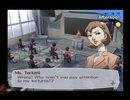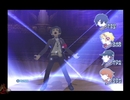|
Shortly after a teenager who was orphaned as a young boy transfers to Gekkoukan High School, he is attacked by Shadows, though this assault awakens his Persona, Orpheus, his only chance at defeating them. He soon afterward learns of a few fellow students who share this special ability, as well as of a time period between one day and the next, the Dark Hour, and joins the Special Extracurricular Execution Squad (SEES) to deal with the threat of the Shadows. Atlus's Shin Megami Tensei: Persona 3 marks the Persona subfranchise's debut on the Playstation 2, appearing towards the end of the system's lifecycle and proving to be a much-improved sequel and solid addition to the Megami Tensei series.
The gameplay of Persona 3 is methodical, with many elements to consider in and out of combat. The game follows the day-by-day scholastic lives of the students involved in SEES, with days progressing over a normal calendar year from morning to night. Most of the time, the protagonist will be attending Gekkoukan High School, with the player occasionally gaining a glimpse into several classes he's attending, where sometimes, the teacher will ask him a question or the game will give the player the opportunity to have him dose off during that class. Staying awake and listening, as well as answering questions correctly, will increase social stats such as Academics and Charm, with other activities occasionally increasing a third social stat, Courage.
 The much-feared teacher burn
The much-feared teacher burn
|
|
After school, the protagonist typically has time to perform a number of activities, such as going to the local mall to shop for equipment and items, or sometimes hanging out with various friends, with the player able to establish Social Links with them and build them to up to ten levels. During the evening, the player can rest, study, or visit Tartarus, a mysterious tower into which the high school transforms during the Dark Hour. On ground floor, the player can assemble a party consisting of the protagonist and three allies, and then ascend the tower to fight through its many randomly-generated floors.
Many Shadows freely roam most floors of the Tartarus, with their size typically indicating how many enemies compose them, and the protagonist able to strike them with his weapon for a first strike, with enemies able to do the same as well. In battle, the protagonist can perform a number of moves, such as attacking normally with his weapon, using items, changing the A.I. settings of his allies, and escaping. Special abilities come chiefly in the form of Personas, of which the hero can have many, while his A.I.-controlled allies (with new A.I. options gained sporadically throughout the game) each have only one through the whole game, though they do occasionally evolve and gain further abilities.
If the hero has multiple Personas, he can change his current one once during his turn. Personas can have both MP-consuming magical abilities and HP-consuming physical skills. Moreover, the player eventually gains the ability to scan enemies to check their strength and weaknesses to various types of attacks. Successfully exploiting an enemy's weakness knocks that enemy on the ground, with the character executing the command that does so gaining an additional turn to perform another command. If the player knocks all enemies on the ground and all his or her characters are standing, the party can charge all enemies and deal massive damage to them.
 The hero's Persona abilities are great, but his singing...not so much.
The hero's Persona abilities are great, but his singing...not so much.
|
|
After a battle, the player gains money as well as experience for all characters and the protagonist's current Persona, and occasionally, the game may shuffle a few cards around, with the player able to pick one for various rewards such as additional experience, a new weapon, additional money, and even a new Persona, though the game limits how many Personas the protagonist can have at once, a limit that sporadically increases throughout the game. At the bottom of Tartarus, moreover, the player can visit the Velvet Room where he or she can fuse Personas into more powerful incarnations. Depending upon the protagonist's Social Links with certain characters and types of fused Personas, they will gain bonus experience and levels.
The battle system mostly works well, with the strategy of exploiting enemy weaknesses inherited from previous Megami Tensei games serving the game nicely, and while some may complain about the lack of manual control over allies, the game, frankly, would be *too* easy if it allowed this. Of course, the A.I. isn't perfect, with allies sometimes making lousy decisions such as using skills that don't work against enemies, and seeming to hold back at times, but works alright for the most part. That enemies run away from the player's party if their levels are high enough is a nice addition, as well. Overall, combat serves the game well both in and out of battle.
Interaction doesn't detract too heavily from Persona 3, with fairly linear gameplay, and, consequently, no need to waste an eternity finding out how to advance the main storyline, which pretty much progresses itself along. There are some minor issues with shopping for new gear for allies and ally management, but otherwise, the game interfaces decently with the player.
Persona 3 is a very distinct game, even in comparison to its predecessors, with features such as the high school simulation, Social Links, and the idea behind the story very much setting it apart from other role-playing games. Granted, it does borrow some elements from the first two Persona games such as the Persona system, which nonetheless has a large number of tweaks along with the battle system, as well as from more recent Megami Tensei games, such as the strategy of exploiting enemy weaknesses, making it feel like a logical continuation of the series.
 The Second Coming
The Second Coming
|
|
The story has many things going for it, with uniquenesses such as the Dark Hour, a high school transforming into a demon-infested tower at midnight, normal people turning into coffins then, characters shooting themselves in the head to use their special abilities, and so forth. The Social Link system, furthermore, adds considerable depth even to non-player characters, with the main storyline being decently developed and full of interesting twists, as well, despite the sluggish pacing that can occur over the game's modest length. The translation is decent, though Japanese suffixes such as -san and -senpai likely won't make sense to most American gamers. All in all, the plot isn't perfect, but decently glues the game together.
The music, composed by Shoji Meguro, is pretty good, with a number of nice vocal tracks and effectively-used central themes. The voice acting during cutscenes is okay, although during battle, it can become fairly grating, with voices accompanying just about every move, sometimes taking the player for an idiot. Granted, the player can turn it off, though this option, unfortunately, is universal, and even so still leaves some voice clips in battle. Overall, the music helps the game far more than hurts, although the voice acting is very much hit-or-miss.
Persona 3 has a superb visual style, with nice character models, art, colors, and splendid environs and architecture, especially in the Tartarus. The combat graphics also work well, with fluid animation and ability effects. The only real blemish is the extremely dorky dodge animation of enemies, but otherwise, the graphics leave little, if any, room for improvement.
Finally, even for a linear game, Persona 3 is surprisingly long, taking somewhere from sixty to ninety hours to complete, with little to boost playing time aside from leveling up in the Tartarus and a replay mode accessed upon beating the game. All things considered, Shin Megami Tensei: Persona 3 is a solid addition to Atlus's flagship franchise, preserving the good ideas of its predecessors in the Persona subseries while leaving out the bad ideas and introducing its own nice quirks. Granted, the game does have some blemishes such as excessive battle voicework, but these flaws don't detract too heavily from an otherwise solid experience.
Review Archives
|









